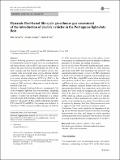| dc.contributor.author | Garcia, Rita | |
| dc.contributor.author | Freire, Fausto | |
| dc.contributor.author | Gregory, Jeremy | |
| dc.date.accessioned | 2016-10-03T19:43:07Z | |
| dc.date.available | 2016-10-03T19:43:07Z | |
| dc.date.issued | 2015-07 | |
| dc.date.submitted | 2015-02 | |
| dc.identifier.issn | 0948-3349 | |
| dc.identifier.issn | 1614-7502 | |
| dc.identifier.uri | http://hdl.handle.net/1721.1/104642 | |
| dc.description.abstract | Purpose
Reducing greenhouse gas (GHG) emissions from the transportation sector is the goal of several current policies and battery electric vehicles (BEVs) are seen as one option to achieve this goal. However, the introduction of BEVs in the fleet is gradual and their benefits will depend on how they compare with increasingly more energy-efficient internal combustion engine vehicles (ICEVs). The aim of this article is to assess whether displacing ICEVs by BEVs in the Portuguese light-duty fleet is environmentally beneficial (focusing on GHG emissions), taking into account the dynamic behavior of the fleet.
Methods
A dynamic fleet-based life-cycle assessment (LCA) of the Portuguese light-duty fleet was performed, addressing life-cycle (LC) GHG emissions through 2030 across different scenarios. A model was developed, integrating: (i) a vehicle stock sub-model of the Portuguese light-duty fleet; and (ii) dynamic LC sub-models of three vehicle technologies (gasoline ICEV, diesel ICEV and BEV). Two metrics were analyzed: (i) Total fleet LC GHG emissions (in Mton CO2 eq); and (ii) Fleet LC GHG emissions per kilometer (in g CO2 eq/km). A sensitivity analysis was performed to assess the influence of different parameters in the results and ranking of scenarios.
Results and discussion
The model baseline projected a reduction of 30–39 % in the 2010–2030 fleet LC GHG emissions depending on the BEV fleet penetration rate and ICEV fuel consumption improvements. However, for BEV introduction in the fleet to be beneficial compared to an increasingly more efficient ICEV fleet, a high BEV market share and electricity emission factor similar or lower to the current mix (485 g CO2 eq/kWh) need to be realized; these conclusions hold for the different conditions analyzed. Results were also sensitive to parameters that affect the fleet composition, such as those that change the vehicle stock, the scrappage rate, and the activity level of the fleet (11–19 % variation in GHG emissions in 2030), which are seldom assessed in the LCA of vehicles. The influence of these parameters also varies over time, becoming more important as time passes. These effects can only be captured by assessing Total fleet GHG emissions over time as opposed to the GHG emissions per kilometer metric.
Conclusions
These results emphasize the importance of taking into account the dynamic behavior of the fleet, technology improvements over time, and changes in vehicle operation and background processes during the vehicle service life when assessing the potential benefits of displacing ICEVs by BEVs. | en_US |
| dc.description.sponsorship | MIT-Portugal Program | en_US |
| dc.description.sponsorship | Fonds Europeen de Developpement Economique et Regional (FEDER, Programa Operacional Factores de Competitividade--COMPETE) | en_US |
| dc.description.sponsorship | Fundação para a Ciência e a Tecnologia (Portugal) (project grant FCOMP-01-0124-FEDER-029055 (PTDC/EMS-ENE/1839/2012)) | en_US |
| dc.description.sponsorship | Fundação para a Ciência e a Tecnologia (Portugal) (project grant FCOMP-01-0124-FEDER-021495 (PTDC/SEN-TRA/117251/2010)) | en_US |
| dc.description.sponsorship | Fundação para a Ciência e a Tecnologia (Portugal) (project grant CENTRO-07-0224-FEDER-002004) | en_US |
| dc.description.sponsorship | Fundação para a Ciência e a Tecnologia (Portugal) (doctoral grant SFRH/BD/51299/2010) | en_US |
| dc.publisher | Springer Berlin Heidelberg | en_US |
| dc.relation.isversionof | http://dx.doi.org/10.1007/s11367-015-0921-8 | en_US |
| dc.rights | Article is made available in accordance with the publisher's policy and may be subject to US copyright law. Please refer to the publisher's site for terms of use. | en_US |
| dc.source | Springer Berlin Heidelberg | en_US |
| dc.title | Dynamic fleet-based life-cycle greenhouse gas assessment of the introduction of electric vehicles in the Portuguese light-duty fleet | en_US |
| dc.type | Article | en_US |
| dc.identifier.citation | Garcia, Rita, Jeremy Gregory, and Fausto Freire. “Dynamic Fleet-Based Life-Cycle Greenhouse Gas Assessment of the Introduction of Electric Vehicles in the Portuguese Light-Duty Fleet.” The International Journal of Life Cycle Assessment 20, no. 9 (July 15, 2015): 1287–1299. | en_US |
| dc.contributor.department | Massachusetts Institute of Technology. Department of Civil and Environmental Engineering | en_US |
| dc.contributor.mitauthor | Gregory, Jeremy | |
| dc.relation.journal | International Journal of Life Cycle Assessment | en_US |
| dc.eprint.version | Author's final manuscript | en_US |
| dc.type.uri | http://purl.org/eprint/type/JournalArticle | en_US |
| eprint.status | http://purl.org/eprint/status/PeerReviewed | en_US |
| dc.date.updated | 2016-08-18T15:36:46Z | |
| dc.language.rfc3066 | en | |
| dc.rights.holder | Springer-Verlag Berlin Heidelberg | |
| dspace.embargo.terms | N | en |
| mit.license | PUBLISHER_POLICY | en_US |
